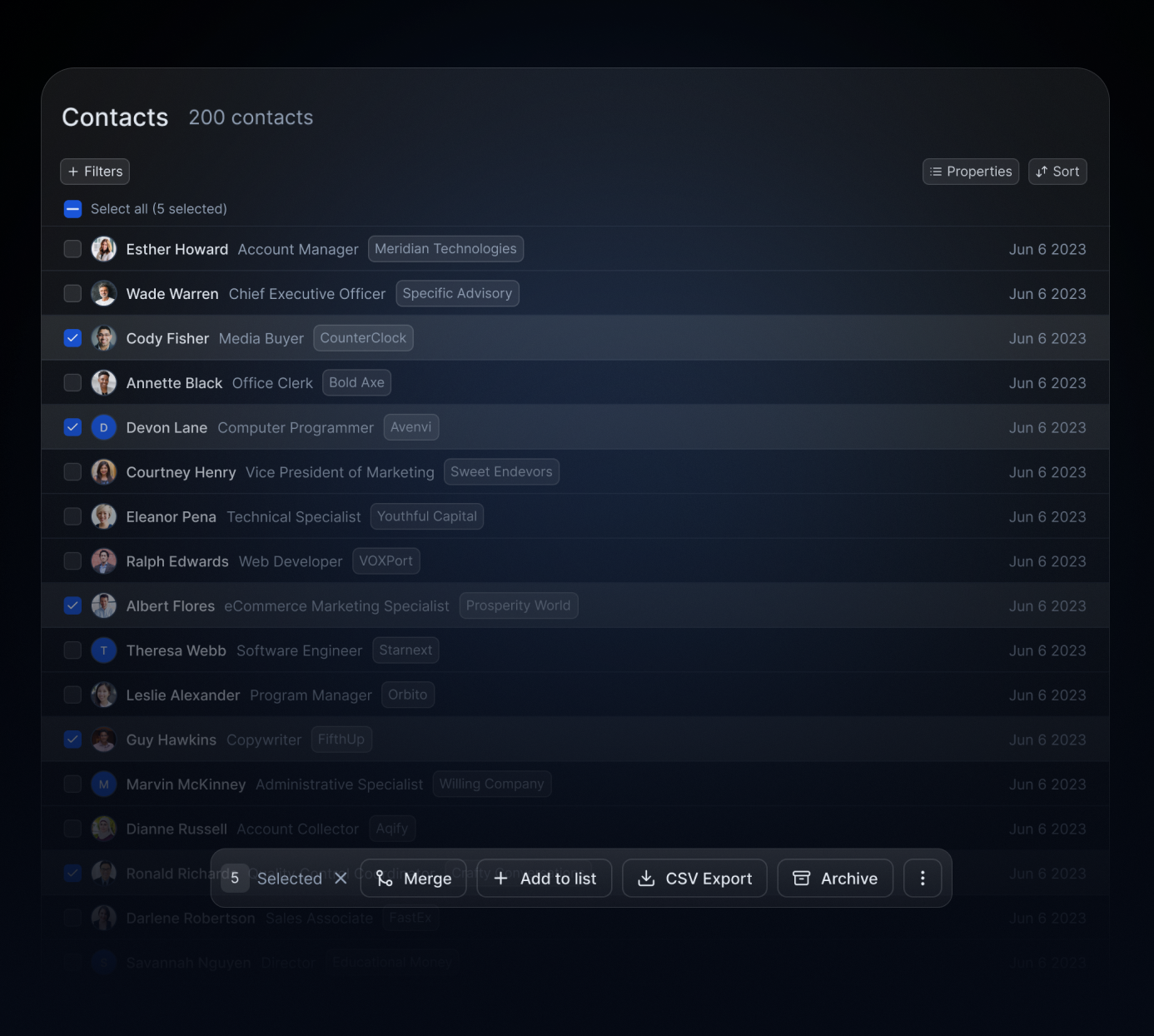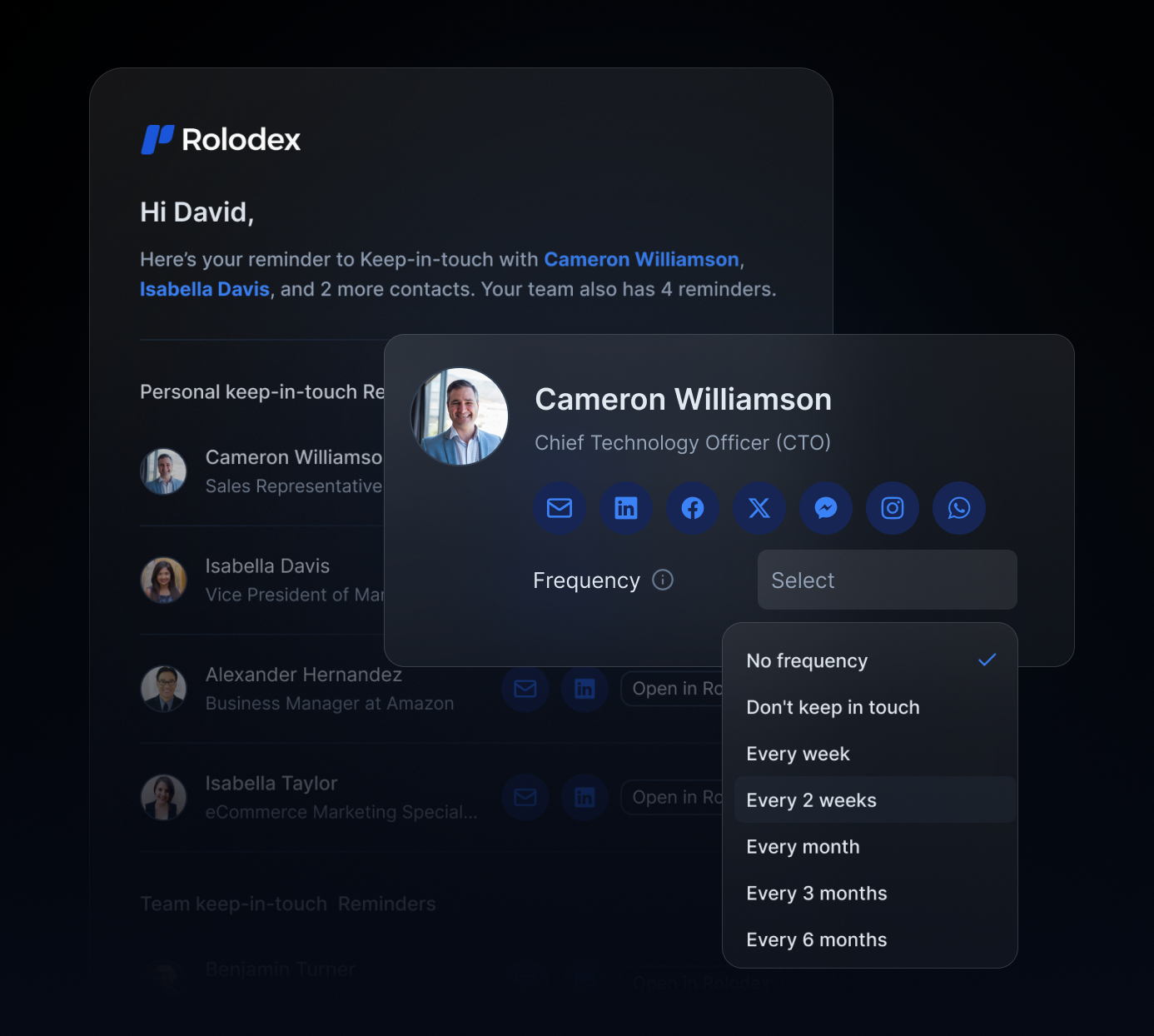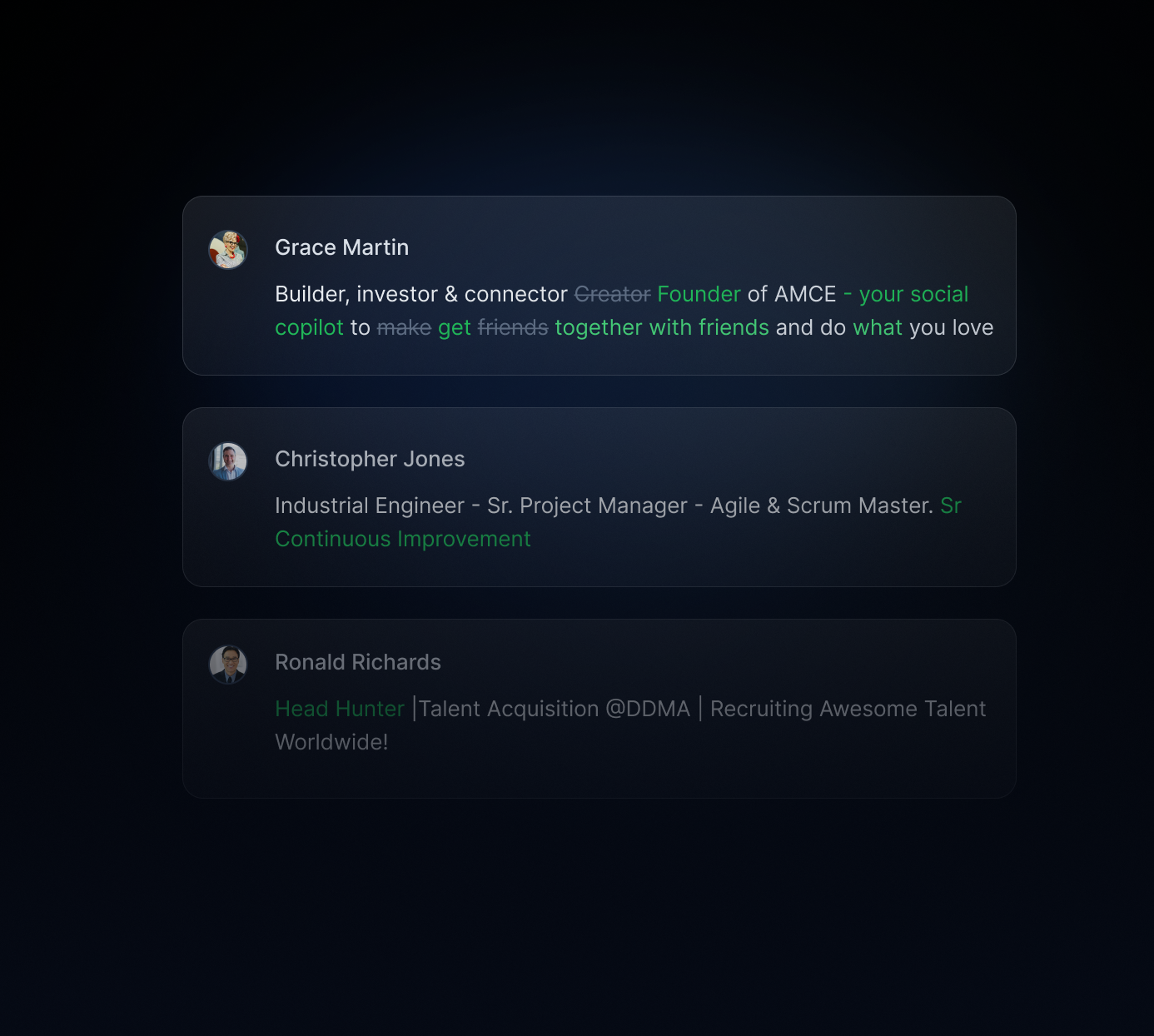Lina didn’t expect much from a casual DM—just a quick sanity check about a payments partner. The reply turned into an intro with the partner’s VP, which turned into a pilot, which turned into real revenue. The VP wasn’t a friend-of-a-friend. He was a friend-of-a-loose-acquaintance. That’s the quiet power of weak ties: people at the edge of your network who see different information, hear different rumors, and open different doors.
This isn’t a feel-good myth. Decades of research—and a massive recent experiment—show that acquaintances, dormant ties, and “bridges” between groups often create more opportunity than the people you talk to every day. The catch is that loose connections cool off fast if you don’t maintain them. Below, we unpack the science behind weak ties and translate it into a practical, lightweight system in Rolodex to keep those edges warm without adding another full-time job.
The case for weak ties (and why they matter more than you think)
In 1973, sociologist Mark Granovetter studied how people actually found jobs. His surprising finding: weak ties—casual connections and acquaintances—were more likely than close friends to lead to new roles, because they connected job seekers to different pockets of information and opportunity. Strong ties knew the same people and the same openings; weak ties lived in adjacent circles and heard different news.
Half a century later, researchers ran a causal, at-scale test using LinkedIn’s feed and recommendation mechanics. Over five years, they varied the prevalence of weak ties for millions of people and tracked more than 600,000 job moves. The result: weak ties causally increased job mobility, with the effect strongest for ties of moderate weakness—neither too close nor too distant. In other words, the “sweet spot” for opportunity is often loose, recently touched connections.
The story doesn’t end there. Studies of dormant ties—people you once knew well but haven’t contacted in years—show that reconnecting them can outperform current ties: you get the familiarity and trust of a strong tie and the novel information of a weak tie. Executives who deliberately rekindled dormant relationships reported more useful insights, broader perspectives, and faster progress on complex projects.
Finally, network scholars like Ronald Burt add an important layer: people who bridge “structural holes”—gaps between groups—consistently generate better ideas and spot opportunities earlier, precisely because they straddle different information flows. Weak ties are the wiring that lets you bridge those gaps.
Bottom line: Weak ties and dormant ties connect you to non-redundant information and people. They’re the fastest path to new jobs, deals, partners, and ideas—if you keep them from going cold.
A note on nuance (diversity vs. bandwidth)
One caveat from MIT’s Sinan Aral and Marshall Van Alstyne: there’s a diversity–bandwidth tradeoff. Weak ties expose you to diverse information, but you interact less often across them. Strong ties have higher “bandwidth” (more frequent, richer interaction) and can deliver more total novelty over time in certain contexts. The key is having both: a diverse perimeter of weak ties to discover opportunities and a high-bandwidth core of strong ties to execute.
Turn the science into a system (with Rolodex)
The research is clear; the real question is operational: How do you keep loose connections warm without drowning in admin? Here’s a repeatable workflow inside Rolodex that respects your time and compounds your luck.
1) See the edges of your network—on one page
Connect email and LinkedIn, then open Rolodex to search and filter your shared network by role, company, seniority, industry, or city. You’ll immediately see who knows whom across your team, plus the Activity Feed on each contact: last meeting, notes, files, introductions. That context lets you engage an acquaintance without re-introducing yourself or asking questions you already asked.
Why it works: Weak ties win when they deliver new information. Filtering by company, city, or specialty helps you surface exactly the non-redundant edges Burt describes—and the feed keeps you from fumbling the basics.

2) Keep weak ties warm with tiny, timely nudges
Set Keep-in-Touch rules for segments likely to pay off via weak ties: former colleagues, alumni, industry peers, event acquaintances. Choose a light cadence—every 6–12 months—and pair it with Title Alerts so promotions and job moves trigger a quick “congrats” or check-in at exactly the right moment.
Why it works: The LinkedIn experiment found the sweet spot in moderately weak ties—relationships that aren’t daily but aren’t dead. Light, well-timed touches keep you in that zone.

3) Reconnect dormant ties with a one-screen message
Once a week, filter your contacts for no activity in 12–24 months. Pick two people. Open their Activity Feed, skim your last note, and send a single-scroll message: one line that references your shared past, one line that adds value (an intro, a resource, a relevant update), one optional line to propose a quick catch-up.
Why it works: Research shows that dormant ties deliver a unique mix of trust and novelty. A small, authentic nudge reactivates that advantage.

4) Turn loose ties into warm intros—then track them like assets
When a weak tie points to someone you should meet, don’t leave it to chance. Use Rolodex to request a warm introduction from the teammate or acquaintance who actually knows the person. Track the ask in a simple Boards View—Requested → Intro Sent → Meeting → Outcome—with a named owner and light SLAs (reply within 1 business day, propose times within 24 hours, send a thank-you within 24 hours post-meeting).
Why it works: Weak ties create exposure; warm intros convert exposure into meetings. A visible board prevents drops and honors the social contract that makes introductions work.

5) Capture “current truth” after every touch
Right after a call or coffee, open the contact and add a one-screen note: three bullets of what mattered, any decisions or risks, and next steps. Drop relevant files—decks, transcripts, one-pagers—into Attachments. Now anyone on your team can pick up the thread, and dormant ties won’t go truly dark again.
Why it works: Weak ties decay fastest when context evaporates. Notes & Attachments preserve the context that makes the next touch easy (and not awkward).
6) Build bridges on purpose (geography and groups)
Use Map View to plan “city loops”: pick a week you’ll be in Stockholm or Amsterdam, filter your network by location and role, and stack coffee chats and small dinners that mix people from different companies or sub-industries. After the trip, log outcomes and set light nudges.
Why it works: You’re intentionally bridging structural holes—bringing people from different information flows into light contact. That’s the fastest way to manufacture serendipity.

A simple weekly ritual (30 minutes, compounding returns)
5 minutes: Scan Title Alerts and send 2–3 congrats notes.
10 minutes: Re-engage two dormant ties using the one-screen message formula.
10 minutes: Advance any warm-intro cards on your board (reply, propose times, send thanks).
5 minutes: Add/clean Notes & Attachments for the week’s meetings; pin a “current truth” on one strategic contact.
Do this for a quarter and you’ll feel it: more replies, more serendipitous intros, more “we were just talking about this—can you meet our VP?”
FAQs
Are weak ties always better than strong ties? No. You want both. Weak ties (and dormant ties) are great for discovery; strong ties are essential for execution. Aral & Van Alstyne show that high-bandwidth strong ties can deliver more total novelty over time in certain environments. Build a diverse perimeter and a high-trust core.
How weak is “weak”? The 2022 LinkedIn experiment suggests the sweet spot is moderately weak ties—you’ve interacted before, but you’re not in constant contact. That’s exactly what light nudges and alerts help you maintain.
What should I say when rekindling a dormant tie? Keep it short and relevant. Reference how you know each other, offer a specific, useful tidbit (a connection, resource, or insight), and—if appropriate—suggest a 10-minute catch-up. The evidence says it’s worth it.
The punchline
Opportunity hides at the edges of your network. Weak ties deliver the new ideas, the unexpected intros, the invitation to the meeting you didn’t know to ask for. Dormant ties add trust to that novelty. And purposeful bridges between groups create the conditions for good ideas and good deals to emerge.
What used to be a rolodex full of index cards is now a calm, shared system: Rolodex shows you the edges, reminds you when to say hello, helps you route intros, and keeps every scrap of context where your team can use it. Keep your weak ties warm, and your luck won’t feel like luck for long.
Sources & further reading
Granovetter, “The Strength of Weak Ties,” American Journal of Sociology (1973): foundational evidence that weak ties help people find jobs because they connect to different networks. JSTOR+1
Rajkumar et al., “A causal test of the strength of weak ties,” Science (2022): large-scale LinkedIn experiment showing weak ties causally increase job mobility; effect strongest for moderately weak ties. MIT Initiative on the Digital Economy
Levin, Walter, Murnighan, “Dormant Ties: The Value of Reconnecting,” Organization Science (2011): reconnecting previously strong ties yields efficiency, novelty, and trust—often outperforming current ties. GW School of Business
Burt, “Structural Holes and Good Ideas,” American Journal of Sociology (2004): bridging gaps between groups gives earlier access to diverse information and better ideas. bebr.ufl.edu
Aral & Van Alstyne, “The Diversity–Bandwidth Trade-off,” American Journal of Sociology (2011): why you need both diverse (weak-tie) networks and high-bandwidth strong ties.
